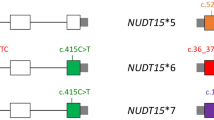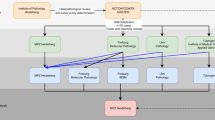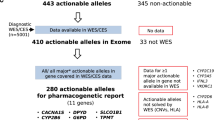Abstract
Preferential conversion of azathioprine or 6-mercaptopurine into methylated metabolites is a major cause of thiopurine resistance. To seek potentially Mendelian causes of thiopurine hypermethylation, we recruited 12 individuals who exhibited extreme therapeutic resistance while taking azathioprine or 6-mercaptopurine and performed whole-exome sequencing (WES) and copy-number variant analysis by array-based comparative genomic hybridisation (aCGH). Exome-wide variant filtering highlighted four genes potentially associated with thiopurine metabolism (ENOSF1 and NFS1), transport (SLC17A4) or therapeutic action (RCC2). However, variants of each gene were found only in two or three patients, and it is unclear whether these genes could influence thiopurine hypermethylation. Analysis by aCGH did not identify any unusual or pathogenic copy-number variants. This suggests that if causative mutations for the hypermethylation phenotype exist they may be heterogeneous, occurring in several different genes, or they may lie within regulatory regions not captured by WES. Alternatively, hypermethylation may arise from the involvement of multiple genes with small effects. To test this hypothesis would require recruitment of large patient samples and application of genome-wide association studies.
This is a preview of subscription content, access via your institution
Access options
Subscribe to this journal
Receive 6 print issues and online access
$259.00 per year
only $43.17 per issue
Buy this article
- Purchase on Springer Link
- Instant access to full article PDF
Prices may be subject to local taxes which are calculated during checkout


Similar content being viewed by others
References
Lennard L . The clinical pharmacology of 6-mercaptopurine. Eur J Clin Pharmacol 1992; 43: 329–339.
Rosenberg JL, Wall AJ, Levin B, Binder HJ, Kirsner JB . A controlled trial of azathioprine in the management of chronic ulcerative colitis. Gastroenterology 1975; 69: 96–99.
Lennard-Jones JE . Azathioprine and 6-mercaptopurine have a role in the treatment of Crohn's disease. Dig Dis Sci 1981; 26: 364–368.
O'Donoghue DP, Dawson AM, Powell-Tuck J, Bown RL, Lennard-Jones JE . Double-blind withdrawal trial of azathioprine as maintenance treatment for Crohn's disease. Lancet 1978; 2: 955–957.
Chouchana L, Narjoz C, Beaune P, Loriot MA, Roblin X . Review article: the benefits of pharmacogenetics for improving thiopurine therapy in inflammatory bowel disease. Aliment Pharmacol Ther 2012; 35: 15–36.
Gearry RB, Barclay ML . Azathioprine and 6-mercaptopurine pharmacogenetics and metabolite monitoring in inflammatory bowel disease. J Gastroenterol Hepatol 2005; 20: 1149–1157.
Smith M, Blaker P, Patel C, Marinaki A, Arenas M, Escuredo E et al. The impact of introducing thioguanine nucleotide monitoring into an inflammatory bowel disease clinic. Int J Clin Pract 2013; 67: 161–169.
van Egmond R, Chin P, Zhang M, Sies CW, Barclay ML . High TPMT enzyme activity does not explain drug resistance due to preferential 6-methylmercaptopurine production in patients on thiopurine treatment. Aliment Pharmacol Ther 2012; 35: 1181–1189.
Chouchana L, Roche D, Jian R, Beaune P, Loriot MA . Poor response to thiopurine in inflammatory bowel disease: how to overcome therapeutic resistance? Clin Chem 2013; 59: 1023–1026.
Roberts RL, Gearry RB, Barclay ML, Kennedy MA . IMPDH1 promoter mutations in a patient exhibiting azathioprine resistance. Pharmacogenomics J 2006; 7: 312–317.
Haglund S, Almer S, Peterson C, Soderman J . Gene expression and thiopurine metabolite profiling in inflammatory bowel disease - novel clues to drug targets and disease mechanisms? PloS One 2013; 8: e56989.
Price MJ, Carson AR, Murray SS, Phillips T, Janel L, Tisch R et al. First pharmacogenomic analysis using whole exome sequencing to identify novel genetic determinants of clopidogrel response variability: results of the Genotype Information and Functional Testing (GIFT) exome study. J Am Coll Cardiol 2012; 59: E9.
Tammiste A, Jiang T, Fischer K, Mägi R, Krjutškov K, Pettai K et al. Whole-exome sequencing identifies a polymorphism in the BMP5 gene associated with SSRI treatment response in major depression. J Psychopharmacol 2013; 27: 915–920.
Tiwari AK, Need AC, Lohoff FW, Zai CC, Chowdhury NI, Muller DJ et al. Exome sequence analysis of Finnish patients with clozapine-induced agranulocytosis. Mol Psychiatry 2014; 19: 403–405.
Wagle N, Grabiner BC, Van Allen EM, Hodis E, Jacobus S, Supko JG et al. Activating mTOR mutations in a patient with an extraordinary response on a phase I trial of everolimus and pazopanib. Cancer Discov 2014; 4: 546–553.
Sies C, Florkowski C, George P, Gearry R, Barclay M, Harraway J et al. Measurement of thiopurine methyltransferase activity guides dose-initiation and prevents toxicity from azathioprine. N Z Med J 2005; 118: U1324.
McLeod HL, Lin JS, Scott EP, Pui CH, Evans WE . Thiopurine methyltransferase activity in American white subjects and black subjects. Clin Pharm Ther 1994; 55: 15–20.
Li H, Durbin R . Fast and accurate short read alignment with Burrows-Wheeler transform. Bioinformatics 2009; 25: 1754–1760.
Li H, Handsaker B, Wysoker A, Fennell T, Ruan J, Homer N et al. The Sequence Alignment/Map format and SAMtools. Bioinformatics 2009; 25: 2078–2079.
McKenna A, Hanna M, Banks E, Sivachenko A, Cibulskis K, Kernytsky A et al. The Genome Analysis Toolkit: a MapReduce framework for analyzing next-generation DNA sequencing data. Genome Res 2010; 20: 1297–1303.
DePristo MA, Banks E, Poplin R, Garimella KV, Maguire JR, Hartl C et al. A framework for variation discovery and genotyping using next-generation DNA sequencing data. Nat Genet 2011; 43: 491–498.
Blankenberg D, Kuster GV, Coraor N, Ananda G, Lazarus R, Mangan M et al. Galaxy: a web-based genome analysis tool for experimentalists. In: Ausubel FM, Brent R, Kingston RE, Moore DD, Seidman JG, Smith JA (eds). Current Protocols in Molecular Biology. John Wiley & Sons, Inc.: New Jersey, USA, 2010 pp 19.10.1–19.10.21.
Giardine B, Riemer C, Hardison RC, Burhans R, Elnitski L, Shah P et al. Galaxy: a platform for interactive large-scale genome analysis. Genome Res 2005; 15: 1451–1455.
Goecks J, Nekrutenko A, Taylor J . Galaxy: a comprehensive approach for supporting accessible, reproducible, and transparent computational research in the life sciences. Genome Biol 2010; 11: 2010–2011.
Abecasis GR, Altshuler D, Auton A, Brooks LD, Durbin RM, Gibbs RA et al. A map of human genome variation from population-scale sequencing. Nature 2010; 467: 1061–1073.
Abecasis GR, Auton A, Brooks LD, DePristo MA, Durbin RM, Handsaker RE et al. An integrated map of genetic variation from 1,092 human genomes. Nature 2012; 491: 56–65.
Ng SB, Turner EH, Robertson PD, Flygare SD, Bigham AW, Lee C et al. Targeted capture and massively parallel sequencing of 12 human exomes. Nature 2009; 461: 272–276.
Kircher M, Witten DM, Jain P, O'Roak BJ, Cooper GM, Shendure J . A general framework for estimating the relative pathogenicity of human genetic variants. Nat Genet 2014; 46: 310–315.
Cooper GM, Stone EA, Asimenos G, Green ED, Batzoglou S, Sidow A . Distribution and intensity of constraint in mammalian genomic sequence. Genome Res 2005; 15: 901–913.
Cooper GM, Goode DL, Ng SB, Sidow A, Bamshad MJ, Shendure J et al. Single-nucleotide evolutionary constraint scores highlight disease-causing mutations. Nat Methods 2010; 7: 250–251.
Adzhubei IA, Schmidt S, Peshkin L, Ramensky VE, Gerasimova A, Bork P et al. A method and server for predicting damaging missense mutations. Nat Methods 2010; 7: 248–249.
Zaza G, Cheok M, Krynetskaia N, Thorn C, Stocco G, Hebert JM et al. Thiopurine pathway. Pharmacogenet Genomics 2010; 20: 573–574.
Rosmarin D, Palles C, Pagnamenta A, Kaur K, Pita G, Martin M et al. A candidate gene study of capecitabine-related toxicity in colorectal cancer identifies new toxicity variants at DPYD and a putative role for ENOSF1 rather than TYMS. Gut 2014; 64: 111–120.
Karas-Kuzelicki N, Milek M, Mlinaric-Rascan I . MTHFR and TYMS genotypes influence TPMT activity and its differential modulation in males and females. Clin Biochem 2010; 43: 37–42.
Milek M, Smid A, Tamm R, Kuzelicki NK, Metspalu A, Mlinaric-Rascan I . Post-translational stabilization of thiopurine S-methyltransferase by S-adenosyl-L-methionine reveals regulation of TPMT*1 and *3C allozymes. Biochem Pharmacol 2012; 83: 969–976.
Smith MA, Marinaki AM, Arenas M, Shobowale-Bakre M, Lewis CM, Ansari A et al. Novel pharmacogenetic markers for treatment outcome in azathioprine-treated inflammatory bowel disease. Aliment Pharmacol Ther 2009; 30: 375–384.
Stocco G, Yang W, Crews KR, Thierfelder WE, Decorti G, Londero M et al. PACSIN2 polymorphism influences TPMT activity and mercaptopurine-related gastrointestinal toxicity. Hum Mol Genet 2012; 21: 4793–4804.
Blaker PA, Peters van Ton AM, Arenas Hernandez M, Smith MA, Smith CH, Irving P et al. PWE-234: optimising the response to thiopurine therapy: a search for novel explanations for thiopurine hypermethylation. Gut 2012; 61: A393.
Duley JA, Somogyi AA, Martin JH . The future of thiopurine pharmacogenomics. Pharmacogenomics 2012; 13: 1549–1552.
Hindorff LA, MacArthur J, Morales J, Junkins HA, Hall PN, Klemm AK et al. A Catalog of Published Genome-Wide Association Studies. 2014 (accessed 18 August 2014). Available from www.genome.gov/gwastudies.
Czaja AJ . Autoimmune hepatitis – approach to diagnosis. MedGenMed 2006; 82: 55.
MacDonald JR, Ziman R, Yuen RKC, Feuk L, Scherer SW . The database of genomic variants: a curated collection of structural variation in the human genome. Nucleic Acids Res 2014; 42: D986–D992.
Preacher KJ . Calculation for the chi-square test: an interactive calculation tool for chi-square tests of goodness of fit and independence (computer software), 2001. Available from http://quantpsy.org.
The UniProt Consortium. Activities at the Universal Protein Resource (UniProt). Nucleic Acids Res 2014; 42: D191–D198.
He Y, Hoskins JM, McLeod HL . Copy number variants in pharmacogenetic genes. Trends Mol Med 2011; 17: 244–251.
Frayne J, Hall L . The gene for the human tMDC I sperm surface protein is non-functional: implications for its proposed role in mammalian sperm-egg recognition. Biochem J 1998; 334: 171–176.
Matimba A, Li F, Livshits A, Cartwright CS, Scully S, Fridley BL et al. Thiopurine pharmacogenomics: association of SNPs with clinical response and functional validation of candidate genes. Pharmacogenomics 2014; 15: 433–447.
Blaker PA, Arenas-Hernandez M, Smith MA, Shobowale-Bakre EA, Fairbanks L, Irving PM et al. Mechanism of allopurinol induced TPMT inhibition. Biochem Pharmacol 2013; 86: 539–547.
Karas-Kuzelicki N, Jazbec J, Milek M, Mlinaric-Rascan I . Heterozygosity at the TPMT gene locus, augmented by mutated MTHFR gene, predisposes to 6-MP related toxicities in childhood ALL patients. Leukemia 2009; 23: 971–974.
Marelja Z, Stöcklein W, Nimtz M, Leimkühler S . A novel role for human Nfs1 in the cytoplasm: Nfs1 acts as a sulfur donor for MOCS3, a protein involved in molybdenum cofactor biosynthesis. J Biol Chem 2008; 283: 25178–25185.
Hille R . The mononuclear molybdenum enzymes. Chem Rev 1996; 96: 2757–2816.
Johnson JL, Waud WR, Rajagopalan KV, Duran M, Beemer FA, Wadman SK . Inborn errors of molybdenum metabolism: combined deficiencies of sulfite oxidase and xanthine dehydrogenase in a patient lacking the molybdenum cofactor. Proc Natl Acad Sci USA 1980; 77: 3715–3719.
Togawa N, Miyaji T, Izawa S, Omote H, Moriyama Y . A Na+-phosphate cotransporter homologue (SLC17A4 protein) is an intestinal organic anion exporter. Am J Physiol Cell Physiol 2012; 302: C1652–C1660.
Humphries JD, Byron A, Bass MD, Craig SE, Pinney JW, Knight D et al. Proteomic analysis of integrin-associated complexes identifies RCC2 as a dual regulator of Rac1 and Arf6. Sci Signal 2009; 2: ra51.
Bronk JR, Lister N, Shaw MI . Transport and metabolism of 6-thioguanine and 6-mercaptopurine in mouse small intestine. Clin Sci (Lond) 1988; 74: 629–638.
Drögemöller BI, Wright GE, Niehaus DJ, Emsley R, Warnich L . Next-generation sequencing of pharmacogenes: a critical analysis focusing on schizophrenia treatment. Pharmacogenet Genomics 2013; 23: 666–674.
Acknowledgements
This work was supported by Jim and Mary Carney Charitable Trust and University of Otago Research Grant.
Author information
Authors and Affiliations
Corresponding author
Ethics declarations
Competing interests
The authors declare no conflict of interst
Additional information
Supplementary Information accompanies the paper on the The Pharmacogenomics Journal website
Supplementary information
PowerPoint slides
Rights and permissions
About this article
Cite this article
Chua, E., Cree, S., Barclay, M. et al. Exome sequencing and array-based comparative genomic hybridisation analysis of preferential 6-methylmercaptopurine producers. Pharmacogenomics J 15, 414–421 (2015). https://doi.org/10.1038/tpj.2015.9
Received:
Revised:
Accepted:
Published:
Issue Date:
DOI: https://doi.org/10.1038/tpj.2015.9



